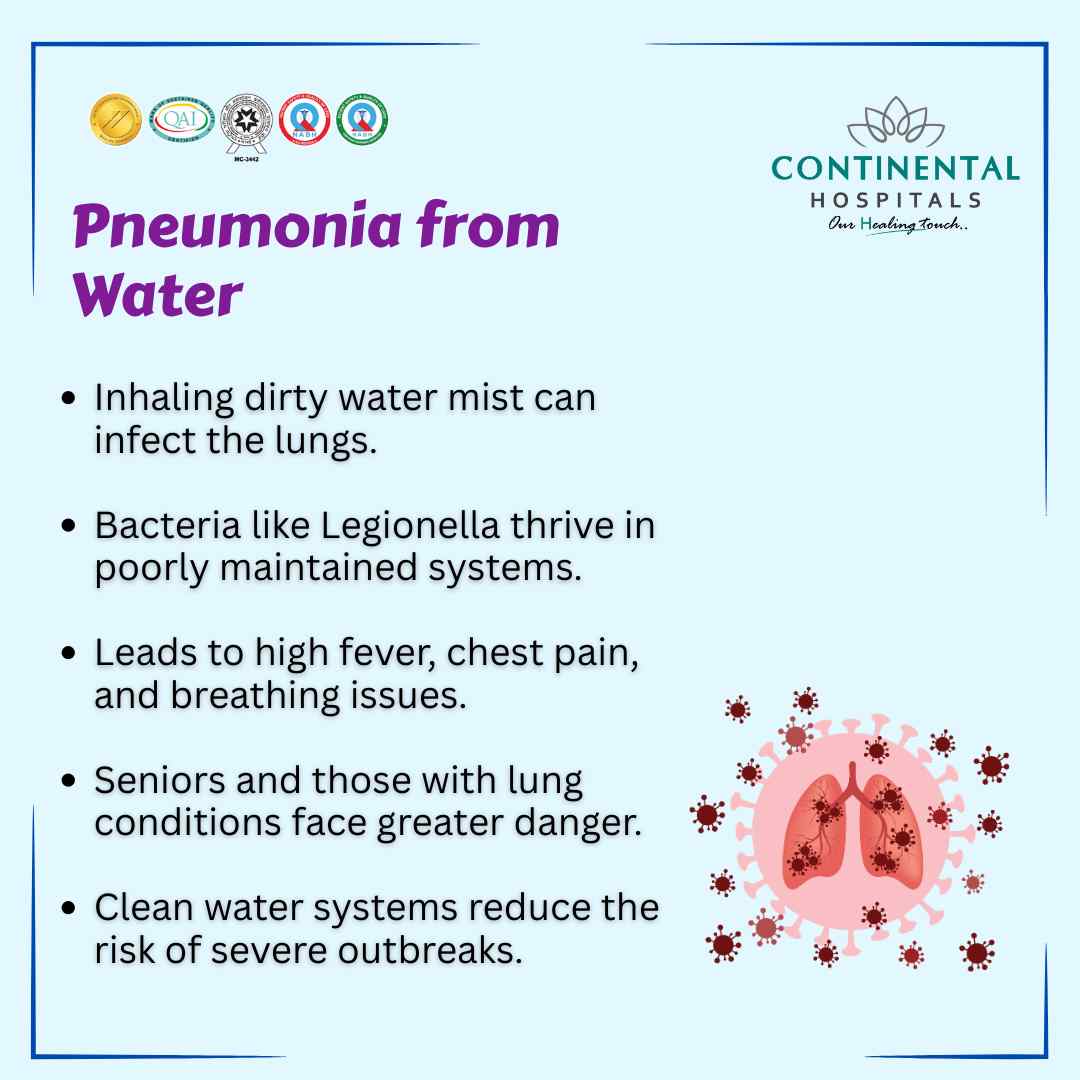Clean water is essential for life, but when it's contaminated, it can quietly become one of the biggest health risks we face. While most people think of stomach infections or skin diseases when it comes to dirty water, one lesser-known and dangerous threat is severe pneumonia. Yes, the water you drink, bathe in, or even inhale droplets from can carry harmful bacteria that reach deep into your lungs. Let’s break this down simply, clearly, and in a way that helps you stay informed and protected.
How Can Water Cause Pneumonia?
To understand how contaminated water can lead to pneumonia, we first need to look at what pneumonia actually is. It’s a lung infection where the air sacs (alveoli) in your lungs fill with fluid or pus, making it hard to breathe. While viruses are a common cause, certain bacteria found in contaminated water can also be powerful triggers for bacterial pneumonia.
One of the major culprits is Legionella, a bacterium that thrives in stagnant or poorly maintained water systems. When water droplets carrying this bacteria are inhaled through mist from showers, air conditioning units, humidifiers, or even fountains, it can lead to a severe form of pneumonia known as Legionnaires’ disease.

🥗 Healthy Plate Challenge
🍽 Add Your Favorite Dish
Pick Your 6 favorite foods, eat, and see the results.Drag & drop foods onto your plate.
Drop Food Here
Common Sources of Contaminated Water
Water doesn’t have to look dirty to be dangerous. Contaminated water may be present in places you least expect:
- Tap water from poorly maintained plumbing
- Water storage tanks that aren’t regularly cleaned
- Public pools and spas with improper chlorination
- Cooling towers and air conditioning systems in buildings
- Decorative fountains or mist machines in public places
These are all potential breeding grounds for waterborne illnesses that can cause serious lung infections.
Legionella and Pneumonia: What You Should Know
Legionella is the most well-known waterborne bacterium linked to pneumonia. It thrives between 20°C and 50°C and can survive in both natural and man-made water sources.
When inhaled, Legionella infection doesn't always stay mild. It can turn into Legionnaires’ disease, a dangerous type of pneumonia with symptoms that usually show up 2 to 10 days after exposure.
Symptoms to watch for include:
- High fever
- Cough (often dry, sometimes with phlegm)
- Shortness of breath
- Muscle aches
- Fatigue
- Chest pain
In serious cases, it can cause respiratory failure or death if not treated promptly.
Who Is Most at Risk?
Not everyone exposed to contaminated water will get pneumonia. But some groups are more vulnerable, including:
- Older adults, especially those over 50
- People with weakened immune systems
- Smokers or those with chronic lung conditions
- Hospital patients, especially those on ventilators
- Individuals with underlying diseases like diabetes or cancer
For these groups, the combination of water pollution health risk and poor immunity makes infections from water much more likely to progress into severe pneumonia.
Other Waterborne Bacteria That Can Cause Lung Infections
Apart from Legionella, there are other bacteria in contaminated water that can cause pneumonia:
Pseudomonas aeruginosa: Often found in hospital water systems, it can cause healthcare-associated pneumonia, especially in ICU patients.
Nontuberculous mycobacteria (NTM): Present in natural water sources, it can cause lung disease, particularly in people with pre-existing lung conditions.
These organisms are hard to detect and can resist standard antibiotics if the infection isn't diagnosed early.
Water Safety Tips to Lower Your Risk
Preventing pneumonia from water sources is all about improving water safety and being alert to potential exposure. Here’s what you can do:
- Clean and maintain water tanks, plumbing, and filters regularly
- Avoid using old or stagnant water from storage tanks
- Make sure hot water systems are heated to a safe temperature to kill bacteria
- Avoid inhaling steam or mist from unknown public fountains, spas, or cooling systems
- Use sterile water in medical devices like CPAP machines and humidifiers
If you're in a hospital or long-term care facility, ask about water safety measures in place
Simple actions can significantly reduce your risk of infection from water.
Pneumonia Symptoms You Shouldn’t Ignore
Even if you're not sure about the source of the infection, recognizing pneumonia early is crucial. Be on the lookout for:
- Persistent cough with or without mucus
- Fever and chills
- Difficulty breathing or rapid breathing
- Sharp chest pain that worsens with deep breaths
- Sudden fatigue or weakness
If these symptoms develop, especially after possible exposure to contaminated water, seek medical attention without delay.
Why Pneumonia from Water Is a Growing Concern
As cities expand and infrastructure ages, the risk of waterborne illness also increases. Climate change and urban crowding add pressure on water systems, leading to poor sanitation and unclean supply. The presence of unmonitored or poorly maintained water storage systems in both residential and commercial areas only makes things worse.
This is why awareness matters. Pneumonia is often treated like a seasonal illness, but when it stems from water pollution health risks, the issue runs deeper and needs urgent action at both individual and public levels.
Why Choose Continental Hospitals?
At Continental Hospitals, Hyderabad, we don't just treat symptoms—we look at the root cause. Our infectious disease and pulmonary specialists are trained to identify, manage, and treat waterborne infections, including severe forms of bacterial pneumonia and Legionnaires’ disease.
Our facilities include:
- Advanced diagnostic tools to detect rare infections
- Multidisciplinary care with infection control experts, pulmonologists, and intensivists
- Safe, sterilized environments that meet global hygiene standards
- A proactive approach to patient safety and health education
If you're experiencing symptoms that suggest pneumonia or have been exposed to questionable water sources, it’s essential to get checked early.
Final Thoughts
Contaminated water is more than just a cause of stomach bugs or rashes—it can quietly lead to serious lung infections like pneumonia. Legionella infection, bacterial pneumonia, and other waterborne illnesses are not as rare as many believe, especially in crowded, urban environments where water systems aren't always properly maintained.
If you or your loved ones are showing signs of pneumonia or have recently been exposed to potentially unsafe water, consult our best pulmonary specialists at Continental Hospitals.
.webp)














